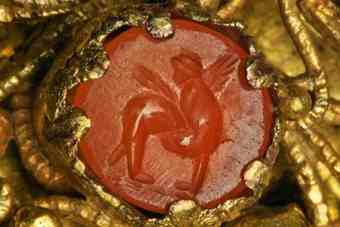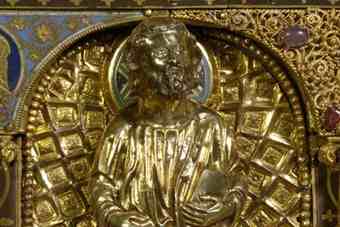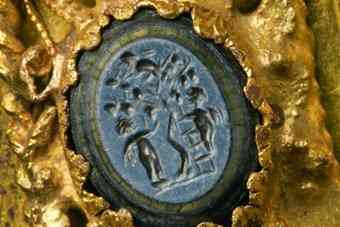Among the Czech Republic's most valuable cultural treasures is the 13th-century Reliquary of St. Maurus, which spent the bulk of the 20th century hidden under floorboards. It is now temporarily on exhibit in the capital city, and the impressive back story of the Romanesque reliquary is matched only by its beauty.
 Milena Bartlová, an art history professor at the Academy of Fine Arts in Prague, called the reliquary "a Romanesque monument of a quality unmatched by any other in the Czech Republic."
Milena Bartlová, an art history professor at the Academy of Fine Arts in Prague, called the reliquary "a Romanesque monument of a quality unmatched by any other in the Czech Republic."
"The amazing use of luxury materials in combination with perfect and elaborated workmanship was a goal of those who produced it, and that is what we can easily admire nowadays," she added.
Based on its shape, the reliquary belongs to so-called house-like relics. It has a wooden core, decorations and statues of gilded silver, precious stones, ancient gems and filigree adornments. The reliquary was originally made for the Benedictine abbey at Florennes, in present-day Belgium, to house the relics of John the Baptist, St. Maurus and St. Timothy in the 13th century.
 It arrived in the Czech lands through Alfred de Beaufort, who bought it in the 19th century and kept it at his castle in Bečov, west Bohemia. During World War II, the de Beaufort family collaborated with the Nazis and, when the war ended, they fled the country, leaving many belongings behind. The reliquary was buried in the castle chapel.
It arrived in the Czech lands through Alfred de Beaufort, who bought it in the 19th century and kept it at his castle in Bečov, west Bohemia. During World War II, the de Beaufort family collaborated with the Nazis and, when the war ended, they fled the country, leaving many belongings behind. The reliquary was buried in the castle chapel.
In 1984, an American businessman offered to pay $250,000 to the Czechoslovak government for the right to search for and take possession of what he called a "monument that won't be missed." This prompted the Criminal Police to begin searching Bečov Castle, and in November 1985, the reliquary was found beneath the chapel floor. Bečov Castle normally exhibits the reliquary but has lent it to Prague Castle.
This is the 25th anniversary of its rediscovery in Bečov, and the Culture Ministry wanted to mark the occasion.
 "The Culture Ministry and National Heritage Institute were looking for a proper venue in Prague and came to us with the idea to exhibit the monument at the Prague Castle," said Václav Beránek from Prague Castle's Department of Culture. "Vladislav Hall at Prague Castle was chosen in part due to the support of First Lady Livia Klausová, who backed the idea."
"The Culture Ministry and National Heritage Institute were looking for a proper venue in Prague and came to us with the idea to exhibit the monument at the Prague Castle," said Václav Beránek from Prague Castle's Department of Culture. "Vladislav Hall at Prague Castle was chosen in part due to the support of First Lady Livia Klausová, who backed the idea."
While the reliquary remains at home in the Czech Republic, Bartlová stressed that the artifact should not be interpreted as a "Czech monument."
"It's scandalous how it is sometimes reported - or rather, not reported - that the reliquary is an import from the Lower Rhineland and that it is German property grabbed by the Czech state on the edge of legitimacy and legality," she said. "At the time of the confiscation, there was no knowledge of the reliquary at the castle."
Although the reliquary does not have a strong connection to local history, its charm and beauty cannot be denied. One can view it as art, a historical object, a religious object or a combination of all three.
 "It should be viewed in a contemporary context: what it means for us here and now," said Martin Vaněk, curator of the Middle Ages Collection of Aleš South Bohemian Gallery. "It shouldn't be viewed just as part of art history or religious life but also in a historical and sociological context."
"It should be viewed in a contemporary context: what it means for us here and now," said Martin Vaněk, curator of the Middle Ages Collection of Aleš South Bohemian Gallery. "It shouldn't be viewed just as part of art history or religious life but also in a historical and sociological context."
Despite its relatively low international profile, the Reliquary of St. Maurus is considered a national treasure second only to the crown jewels.
"I've seen some important monuments of the same kind, and this is a rather average piece. But here in the Czech Republic it is absolutely unique," Bártlová said.
As Martin Vaněk summed up, "It is an important monument that is definitively worth seeing and knowing."
Author: Filip Šenk | Source: The Prague Post [December 01, 2010]















